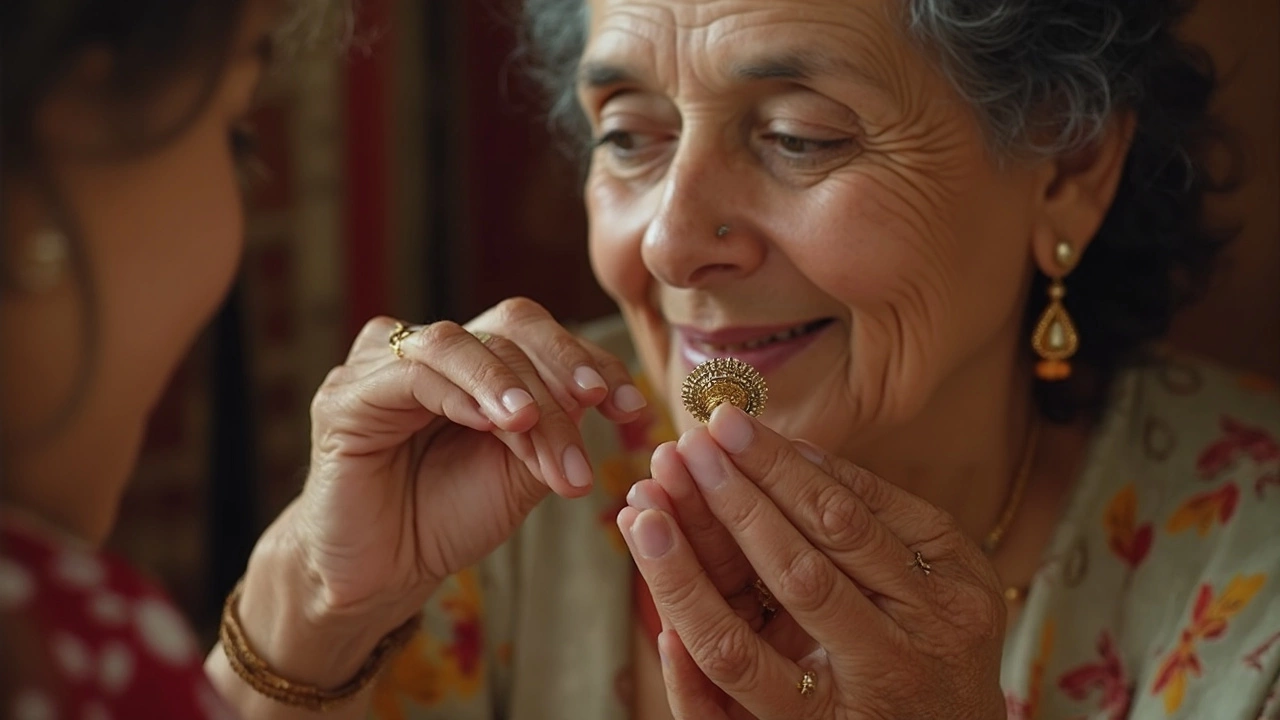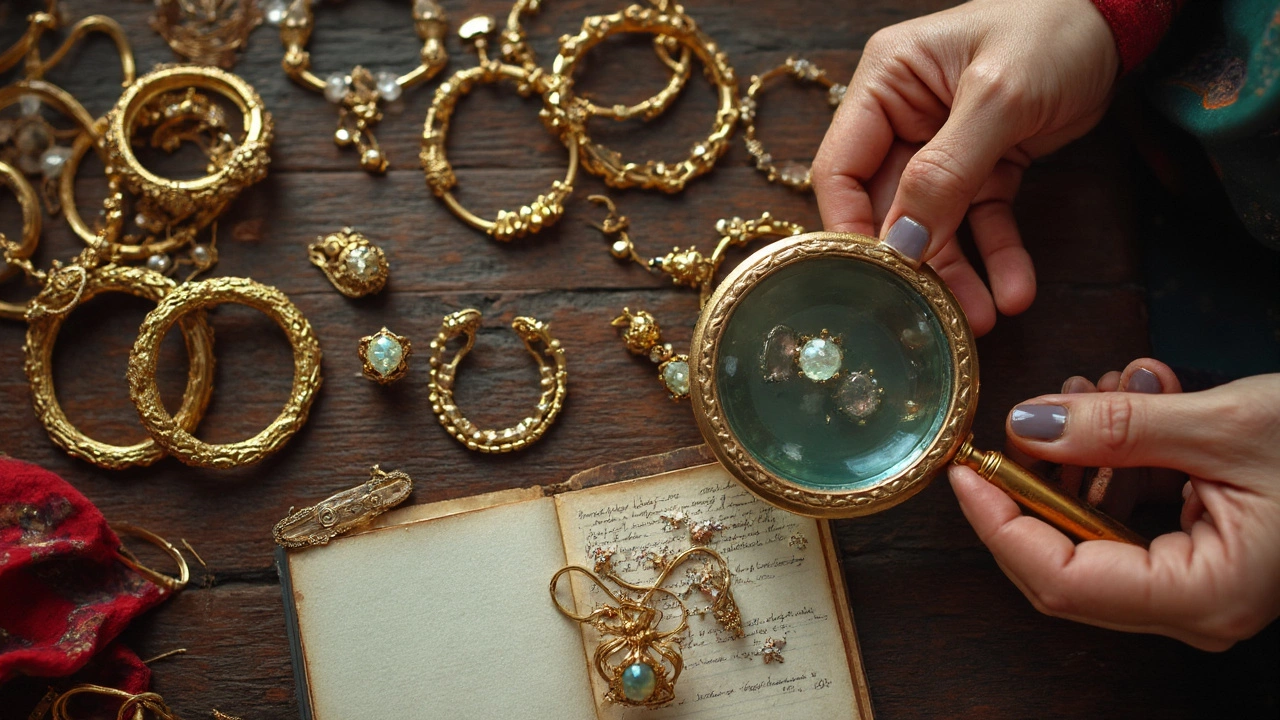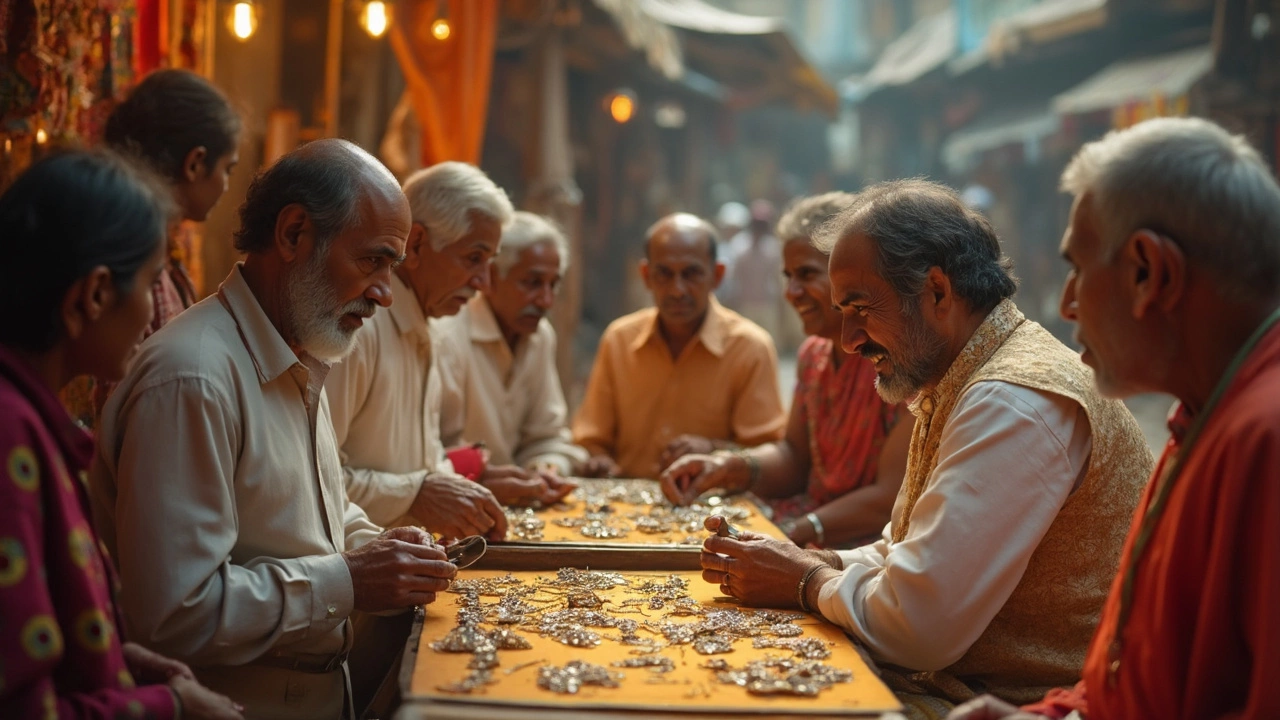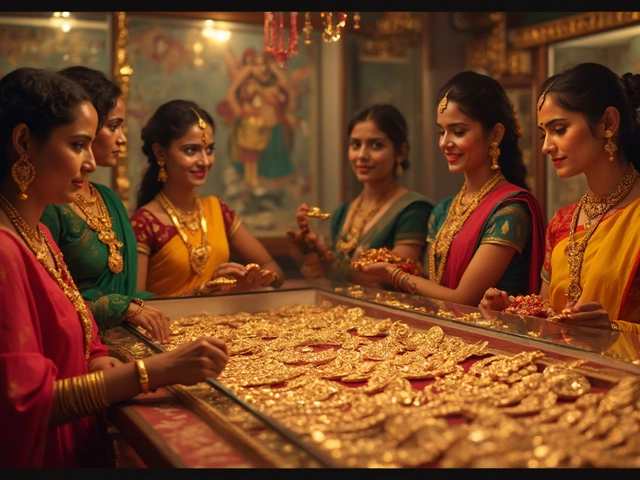
You might have a tangled pile of old jewelry that everyone in your family swears is special. But is it really worth much? The truth is, most people guess wrong. A pretty necklace or a ring that feels heavy doesn’t always mean it's valuable. Some pieces could be gold-plated junk, while a simple brooch nobody likes could pay for your next vacation.
There’s no need for guesswork. You can do some quick checks right at home before you even think about selling or getting it checked by a pro. First off, real gold and silver feel hefty for their size and don’t flake apart. Fake stuff often leaves a green mark on your skin or gets weirdly light as it wears down. Grab a magnet—real gold and silver won’t stick. This quick test won’t make you an expert, but it weeds out the obvious fakes.
Even if something passes these first tests, there’s more to look for. A tiny embossed stamp or number on the clasp or inside a ring can tell you about its metal quality and country of origin. Don’t ignore these—sometimes the smallest marks mean the biggest money.
- Spotting Genuine Materials
- Understanding Hallmarks and Stamps
- Checking Craftsmanship and Design
- Identifying Brands and Provenance
- Getting a Professional Appraisal
Spotting Genuine Materials
Don’t let the shine fool you—plenty of fake pieces sneak into boxes of old jewelry. It’s smart to know what real gold, silver, and precious stones actually look and feel like. Genuine gold, for example, never reacts to a magnet. It’s a super simple trick: grab a fridge magnet and see if your gold chain or ring sticks. If it does, it’s probably just gold-plated over some cheap metal.
Real silver acts a little differently. It will tarnish over time, turning a dull gray, but you can wipe that away with a soft cloth. If you see bright orange or green rust, you’re probably holding something made of base metal, not true silver. Fake silver also tends to be super lightweight.
Gemstones are where it gets tricky. Glass and plastic can feel warm to the touch and weigh less than diamonds, sapphires, or emeralds. Hold the stone near your cheek—real gems often feel cold, at least at first. You can also look for bubbles inside the stone with a magnifying glass. Bubbles usually mean glass, not a precious stone.
- antique jewelry buyers check for weight and heft—real gold and silver feel heavier than fakes.
- Run your finger along the surface. Edges should be smooth, not sharp or poorly finished.
- Check for wear on the corners and clasps. If any yellow, coppery, or silvery under-layer is peeking through, your piece might just be plated.
- Use a soft white cloth to rub the item. Green or black marks are a red flag—likely not precious metal.
Want proof from the pros? The Gemological Institute of America says,
“Magnetism, tarnish, and weight are all quick indicators, but lab testing is ultimate.”So these DIY tricks are a good start—but they aren’t the whole story. Still, getting this part right means you’re already ahead of most pawn shop hunters and weekend estate-sale shoppers.
Understanding Hallmarks and Stamps
If you ever squint at the tiny numbers and symbols stamped on jewelry, you’re not alone. These marks—called hallmarks and stamps—hold the clues to its true makeup. They can tell you if you’re holding solid gold or just a cheap knock-off. In the world of antique jewelry, understanding these marks is like knowing the secret handshake.
Start by flipping over rings, unclasping necklaces, or checking the back of pins for anything etched, stamped, or engraved. Sometimes it takes a magnifier and decent lighting. Here’s what to look for:
- Karat Marks: You might see "14K" or "18K" for gold, or numbers like "585" (which means 58.5% gold, aka 14K). “925” means sterling silver.
- Platinum Stamps: "PT950" or "PLAT" signals platinum, one of the priciest metals out there.
- Makers’ Marks: This could be a tiny logo, initials, or name—sometimes a brand everyone knows, sometimes an old jeweler long forgotten. Famous ones (like Tiffany & Co.) really bump up the value.
- Assay Office Marks: In places like the UK, you’ll see a symbol that shows which official office checked the metal quality, like a leopard’s head for London or an anchor for Birmingham.
- Date Letters: On some older European stuff, you’ll even find a single letter showing the year, like an annual code.
If you want to get technical, check out this breakdown of common hallmark numbers and what they mean:
| Mark | Meaning | Metal |
|---|---|---|
| 925 | 92.5% Silver (Sterling) | Silver |
| 750 | 75% Gold | 18K Gold |
| 585 | 58.5% Gold | 14K Gold |
| 375 | 37.5% Gold | 9K Gold |
| PT950 | 95% Platinum | Platinum |
Sometimes there’s no visible mark—maybe it wore away, or the piece is really old (before marking was common). But these marks are usually your first big clue about what you’re dealing with. Whenever you see one, jot it down or snap a picture. A quick online search can help, or you can compare it with official hallmark charts.
The bottom line: if you spot solid karat or platinum marks, and the stamp looks crisp—not messy or obviously fake—you're off to a great start. Those old, barely-there stamps on antique jewelry matter a lot, so don’t overlook them.

Checking Craftsmanship and Design
Okay, so you’ve figured out your jewelry isn’t fake metal. Now it’s time to look at how it’s made and what it really looks like. Quality craftsmanship is the difference between a piece that’s just old and one that’s seriously collectible. Badly made stuff falls apart, looks uneven up close, and often has stones that don’t line up. Good antique jewelry, on the other hand, holds up for generations and keeps its shine, even after sitting in a dusty drawer.
Flip your jewelry over and check the back. Genuine, valuable pieces usually have tidy, finished backs — think smooth welds, clean edges, and no random glue blobs. If anything feels sharp or unfinished, that’s a red flag. If you see screws or rough solder spots, that’s another sign the piece may be cheap or poorly repaired.
The design also tells a story. For example, jewelry from the Victorian era (1837–1901) often features intricate filigree, hand-engraved patterns, and motifs like hearts, flowers, and snakes. Art Deco pieces from the 1920s–30s pop with bold geometric patterns and bright colored stones. Pieces from big names—like Cartier, Tiffany & Co., or Fabergé—sometimes look simple but are engineered perfectly. Don’t let “simple” designs fool you if the finishing touches scream quality.
- Check stone settings: High-value antique jewelry usually has stones set by hand, not glued. Prongs should be even, neat, and well-placed.
- Look for symmetry: Even tiny details on vintage earrings or brooches match up. Lopsided stones, rough bezels, or uneven goldwork hint that something’s off.
- Inspect clasps and hinges: Antique brooches and necklaces often have unique, sturdy fastenings. A trombone clasp, for example, is a clue for French jewelry from early 1900s.
It’s easy to think newer means shinier, but sometimes, the patina—those small marks from decades of wear—adds value. Never scrub away these spots without asking a pro first.
| Era | Common Materials | Design Features |
|---|---|---|
| Victorian (1837–1901) | Yellow gold, seed pearls, garnet | Filigree, engraving, symbolism |
| Edwardian (1901–1915) | Platinum, diamonds, pearls | Delicate, lacy motifs, bows, garlands |
| Art Deco (1920–1935) | White gold, platinum, enamel, sapphires | Geometric, bold color, streamlined |
| Retro (1935–1950) | Rose gold, rubies, large stones | Chunky, bright, oversized designs |
In short, when checking antique jewelry for value, craftsmanship and design are your best clues. The neater and more precise the work, the more likely you’ve got something special on your hands.
Identifying Brands and Provenance
One of the biggest ways to bump up the value of old jewelry is figuring out where it was made and who designed it. A piece from a famous brand like Cartier, Tiffany & Co., or Van Cleef & Arpels can turn an ordinary-looking trinket into something really valuable. Even small names might matter—a lot of collectors watch for forgotten designers from the early 1900s or art deco period.
So, how do you sniff out a brand? Flip the piece over and check for a signature, logo, or even a discreet set of initials. Top brands almost always put their name or a unique symbol somewhere, sometimes in tiny print. Grab a magnifying glass if you need to. Don’t just look on the obvious spots—open clasps, check under settings, and glare into the dark corners.
Provenance is a fancy word for the history of a piece. Did it belong to someone famous? Was it made for a special event, or did it travel across continents before ending up in your drawer? Real provenance can give jewelry a huge price tag boost, even if it isn’t the flashiest thing in the box. If there are old family letters, photos, or original receipts, stash those with the piece—they’re often just as important as the jewelry itself.
Some brands and makers have left a major mark in the world of antique jewelry. Here’s a quick look at a few big names you might actually run into, and what their stamps or signatures often look like:
| Brand/Maker | Typical Stamp or Signature | Average Value Jump* |
|---|---|---|
| Tiffany & Co. | Tiffany & Co. / T. & Co. | +30–60% |
| Cartier | Cartier / C | +50–100% |
| Van Cleef & Arpels | VCA / Van Cleef & Arpels | +60–150% |
| Georg Jensen | GJ / Georg Jensen / 925S | +20–40% |
| Bvlgari | Bvlgari / BVLGARI | +40–75% |
*Percentages show the possible increase in resale value over similar pieces without these brands (ballpark figures as of spring 2025 – actual sale prices can be higher if the design is rare or condition is perfect).
If you spot a famous name, don’t get too excited just yet. Fakes show up all the time. Double-check the style, fonts, and placement against photos from official sources. If something feels off, mention it to a professional—you could save yourself from a headache later.
Even if you don’t see a big name, other hints about older makers—like regional marks from France, Britain, or the US—can still add value. These tiny details help trace a piece back to specific workshops or famous areas, like the renowned Hatton Garden in London or Place Vendôme in Paris. With just a few careful checks, you might discover you’re holding more than you thought.

Getting a Professional Appraisal
Sometimes, DIY tricks only take you so far. When you’re unsure or your jewelry looks promising, it’s smart to take it to a professional appraiser. These folks know the difference between a $20 trinket and a $20,000 antique. They use tools and years of experience to nail down an honest value.
First, be picky about where you go. Not every jeweler who offers "free appraisals" actually has proper credentials. Look for someone certified by groups like the American Gem Society (AGS) or the Gemological Institute of America (GIA). These certifications mean your appraiser has serious training and won’t just eyeball your piece. Also, make sure they don’t have any interest in buying what you bring in—their job is to tell you value, not make a lowball offer.
- Bring any paperwork you’ve got—old receipts, previous appraisals, or even vintage boxes. These can bump up the value.
- Ask for a “written” appraisal, not just a quick look. A real appraisal will break down your jewelry by materials, gemstones, designer, age, and condition.
- Expect to pay for the service. In 2024, most reputable appraisers charge $75 to $200 per hour. That’s normal, and a sign you’re getting the real deal.
If your jewelry turns out to have a designer’s mark or rare stones, your appraisal will go even deeper. Some specialists even use x-ray fluorescence (XRF) guns to measure metal purity without scratching your ring. Seriously, jewelers have better gadgets than my kid Felix’s science kit.
| Appraisal Fact | Typical Range |
|---|---|
| Cost per hour for certified appraisal (2024) | $75 - $200 |
| Average time for single item | 15 - 45 minutes |
| Turnaround for written report | 1-7 days |
Why bother with all this? Insurance companies, auction houses, and serious buyers usually won’t even talk to you about payment without a detailed appraisal. A antique jewelry appraisal doesn’t just give you peace of mind—it can be your ticket to a better price or proper coverage if disaster strikes.


